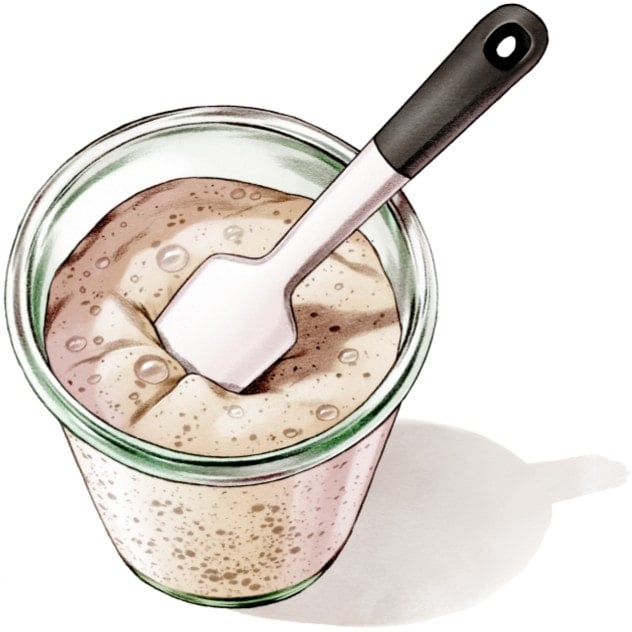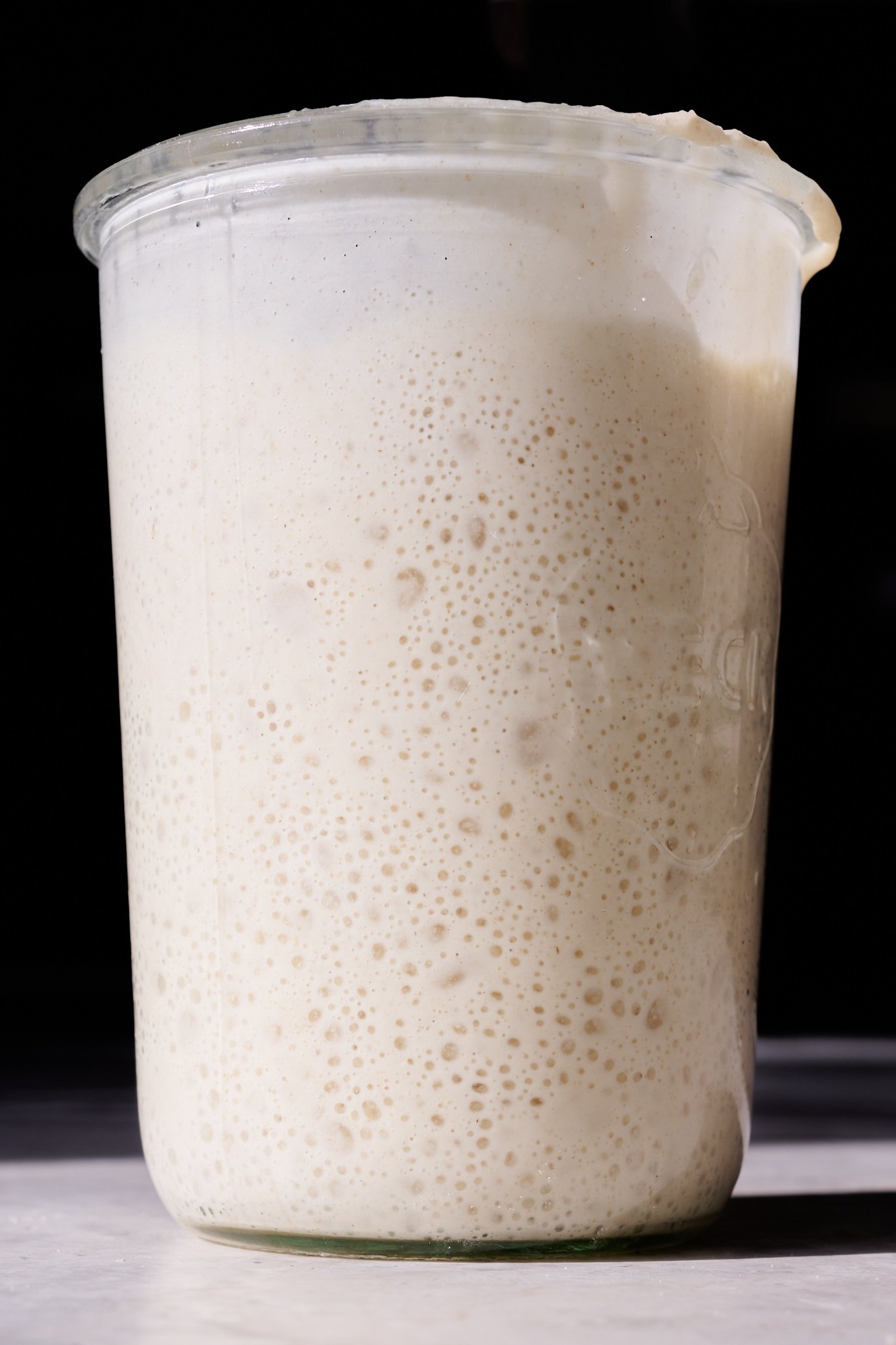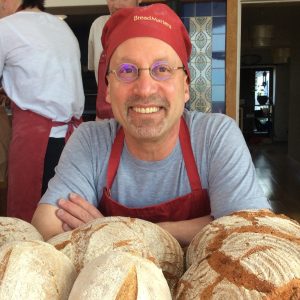In this second post by Eric Pallant, author of Sourdough Culture: A History of Bread Making from Ancient to Modern Bakers and professor at Allegheny College, we take a look at the role of microbes in nature, our sourdough starters, bread dough, and ultimately, our bread. You may never see your starter quite the same way again.
In the Bible, Adam and Eve were asked to leave the Garden of Eden, where all things were free for the taking, and tasked with laboring for their daily sustenance. To eat, they must till soil. Moreover, emphasizes Genesis, Adam is told he will one day return to the earth from which he was first fashioned in the image of God. The Hebrew word for Adam shares the same root as the Hebrew word for soil, adamah.
Adam will not only have to work hard for his daily bread, but when his life has run its course, Adam will return to adamah: “In the sweat of thy face shalt thou eat bread, till thou return unto the ground; for out of it wast thou taken: for dust thou art, and unto dust shalt thou return” Genesis 3:19.The Anglican Church of England’s Book of Common Prayer puts it more succinctly. Upon the burial of a body, a minister reads aloud, “Earth to earth, ashes to ashes, dust to dust.”
There is also a scientific explanation, not incompatible with the Bible. All living things, or any formerly living thing (like a corpse blessed by an Anglican Priest), belong to a category of matter that soil scientists call organic matter. Organic matter is subject to decomposition, but decomposition does not happen on its own.
Hang with me. I’m on my way to sourdough.
A banana peel thrown on a moist forest floor will be gone in a year because the peel contains nutrients that billions of microscopic organisms are happy to feed upon. A fallen oak leaf has nutrition for microbes as does bluebird poop and skunk hairballs. We know they do, because if it were not for the action of microscopic organisms consuming, respiring, decomposing, eating (all these terms mean more or less the same thing) fallen organic matter, layers of autumn leaves and dead weasels would accumulate and remain year over year. A walk in the woods would be a tricky thing indeed.
Among the most important organisms with the invisible job as decomposers are bacteria and fungi, the same critters that reside in sourdough cultures. Yeasts are from the same kingdom as mushrooms, only they do not produce either fine filaments of mycelium or fruiting bodies that look like toadstools. But make no mistake. When a sourdough culture is ripening, bacteria and yeast are…choose your preferred term–decomposing, eating, respiring, fermenting, predigesting…the dead organic matter (you call it dough) in their habitat. You will dispatch them for their efforts in a preheated oven and enjoy the fruits of their labor as sourdough bread.
A Harsh World
The world of decomposition is no Garden of Eden for microscopic organisms. On the contrary, competition for a place at the carcass–or in our case, a mass of dough–can be as fierce as a shark frenzy in freshly chummed water. Only, in the absence of elbows, teeth, snarls, or tails, microscopic organisms battle one another with chemicals, many of which we taste as sour.
“I did not invent penicillin. Nature did that. I only discovered it by accident.”
Sir Alexander Fleming
In 1928, Sir Alexander Fleming placed a petri dish near his window. In it he was growing a bacterium of the genus Staphylococcal. For reasons I cannot imagine, Fleming failed to cover the petri dish, but his failure to do so won him a Nobel Prize and changed the course of humanity. When some mold spores landed on his petri dish they began to grow. Fleming had the wisdom to recognize that immediately surrounding his mold colonies his bacterial colonies were dying. Surrounding each spot of expanding green mold, the agar was clear and completely free of Staphylococci. The genus of mold was Penicillium. The mold juice, as Fleming called it, was penicillin, and even diluted 800 times, penicillin has the capacity to kill Staphylococci bacteria. All this is to say that when food becomes available, competition is vicious, even among microbes. Molds, bacteria, and fungi, including yeasts, do not hesitate to poison one another.

The Nuts and Bolts of Fermentation
When a dough ferments, yeasts start consuming, or decomposing, flour. Individual yeast cells break down starches into simple sugars (a first act of “dust to dust” or returning wheat to the soil from whence it came). As they dine, they release simpler forms of sugar and a pair of useful waste products. One waste product is carbon dioxide. Incidentally, you release the same waste product when you exhale after you consume food. In the case of bread, a well-strengthened gluten network will capture yeast exhalations in tiny pockets that will become, after baking, the bread’s crumb. In the case of liquid bread, also known as beer, a sealed bottle results in a carbonated beverage.
The second product excreted by active yeast is an alcohol called ethanol that is toxic to most species of bacteria. That is why after you cut yourself, one means of keeping bacteria at bay is to wipe down the wound with alcohol. Your goal in doing so is to kill off any bacteria before covering the cut with an antibiotic ointment (another way to kill bacteria) and a band-aid so that as few bacteria as possible get a chance to digest you. This is what happens when yeasts digest sugars. They make alcohol that kills off bacteria. But not all bacteria.
One group of bacteria known as Lactobacilli can swim happily in a sea of ethanol. As Lactobacilli eat the simple sugars presented to them by yeasts the tiny cells of bacteria release acids into the mixture, primarily lactic acid and acetic acid (vinegar). As the populations of bacteria increase, the acidity increases (the pH gets lower). Most nasty species of bacteria—the species that make us sick when they consume us—die in acidic environments. Even mold dies in acidity, which is why sourdough bread, with its very low pH, does not mold readily and stores very well. Mold spores floating about in your kitchen, much like mold spores floating about in Sir Arthur Fleming's laboratory, unquestionably land on your sourdough bread but fail to thrive on its acidic substrate. In contrast, commercial breads leavened with commercial yeast, but absent the bacterial acids found in sourdough breads, must contain fungicides and mold killers. Manufacturers more delicately refer to these substances as preservatives.

A Sourdough SCOBY
The acronym SCOBY stands for Symbiotic Culture of Bacteria and Yeast, and a healthy sourdough starter is an excellent example of one. Inside a sourdough culture are a few species of bacteria that can tolerate ethanol and a few species of yeast that can survive in a soup of lactic and acetic acids–and here we have symbiosis. These species in their mutually beneficial set-up forms the basis of a food preservation technique that has been around for millennia: fermentation. Caring for a SCOBY–in our case, a sourdough culture–is a kind of cultivation of good microorganisms that assist us in preventing the growth of other microscopic organisms that might finish off the process of decomposition (which is what happens when your bread starts growing mold) or make us sick. Fermentation helps preserve everything from sauerkraut, which resists decomposition longer than cabbage, to yogurt, which resists bacteria and molds longer than plain milk.
The ecology of sourdough SCOBYs, i.e. the study of the interaction of microbial species inside a sourdough culture, or what I referred to earlier as the competition for a seat at the carcass (i.e. dough), has been the subject of study for only a comparatively few years. It is not easy to observe multiple species of microscopic organisms battling one another using only dissolved compounds as weapons. What we do know is that compared with many other microbiomes, sourdough cultures are only moderately diverse. Of the 4,000-plus cataloged strains of yeast in the world, only about 70 or so make their homes in sourdough cultures. Likewise, rather than thousands of strains of bacteria, only a few hundred, arrayed among about 60 common species live in sourdough cultures. Most of the research on the bacteria present in sourdough cultures has been paid to species that generate lactic acid (Lactic Acid Bacteria), but recent discoveries suggest that Acetic Acid Bacteria (AAB) may be more important than originally suspected.

What all those species of bacteria have in common is that they excrete acids, compounds that we human beings recognize by their sour taste. But bacteria also excrete dozens, or more, of additional organic compounds at meal time. Yeast also excrete organic compounds, not just ethanol and carbon dioxide. From a microbial perspective, bacteria and yeast release compounds for two primary reasons. First, microscopic organisms, like all living things, get rid of waste products as they go about their daily work of decomposition (fermentation). Second, what departs the cell of a microscopic organism may have the added benefit of knocking off its neighbors.
So, what do excretions have to do with good bread baking? Well, the complexity of a sourdough bread is at least in part a function of what species of bacteria and yeast are present, what compounds each species excretes, what quantities of the excretions remain in the loaf after it has been heated to several hundred degrees (temperatures that cause most liquids and gases to vaporize), and how each of us perceives taste when we put a complicated mixture of compounds into our mouths.
The question for us as bakers comes down to management. Can we encourage a dough to be rich in lactic acid on days when we want a creamy-flavored, buttermilk-inspired loaf? Alternatively, can we create a starter that contains a powerful representation of acetic acid that we can use when we want to make a bread with a knock-you-upside-your-head sense of sourness?
Maybe and maybe not.
Making Sourdough Bread More or Less Sour
If you have nothing better to do for the next hour you can work your way through this comprehensive summary of what is known and what needs to be known: A Review of Sourdough Starters: Ecology, Practices, and Sensory Quality with Applications for Baking and Recommendations for Future Research. Or you can take a spin across the internet to learn what experienced bakers have to say about how best to control dough acidity. After much reading, my take is there is no consensus, though I anticipate that many readers will disagree, having come up with their own method that reliably ensures a degree of sourness that suits them and their cultures just fine.
Here is my explanation for why the management of sourness is far from foolproof. The species of bacteria and yeast that survive in your personal sourdough starter is a function of at least half a dozen variables. Who gave you the starter? How often do you refresh it? At what temperature do you keep it? What microbes live in your kitchen? None of us bakes in a sterile microbiology lab, so new species are constantly assaulting our cultures. What kind of flour are you using and what microbes are introduced to your culture when you offer your yeast and bacteria new organic matter upon which to grow?
Not only does each baker’s formula offer succor to one set of microbes over another, but predicting in advance what a specific combination of flour, water, salt, and starter will produce is more history than science.
Now add to that set of variables at play on your microbes all of the variables that will interact as you mix ingredients. From bread to bread, we change hydrations levels, flour ratios, salt content, proofing times, add-ins of unlimited variety, and baking temperatures from low and slow to hot and fiery. Not only does each baker’s formula offer succor to one set of microbes over another, but predicting in advance what a specific combination of flour, water, salt, and starter will produce is more history than science. We bake, we record, we taste, and then we repeat if we like the results.
Adam and Eve were expelled from the Garden of Eden to a life of labor, perspiration, and cultivation. Worse, the pair had to forsake the Tree of Life and face the prospect of Adam returning to adamah, the soil from which he was created. All living things, people and wheat included, are destined to be food for microscopic organisms. While we are here, let us focus on the joy and experimentation of working with our invisible companions and together make the Staff of Life.
Bake on.





